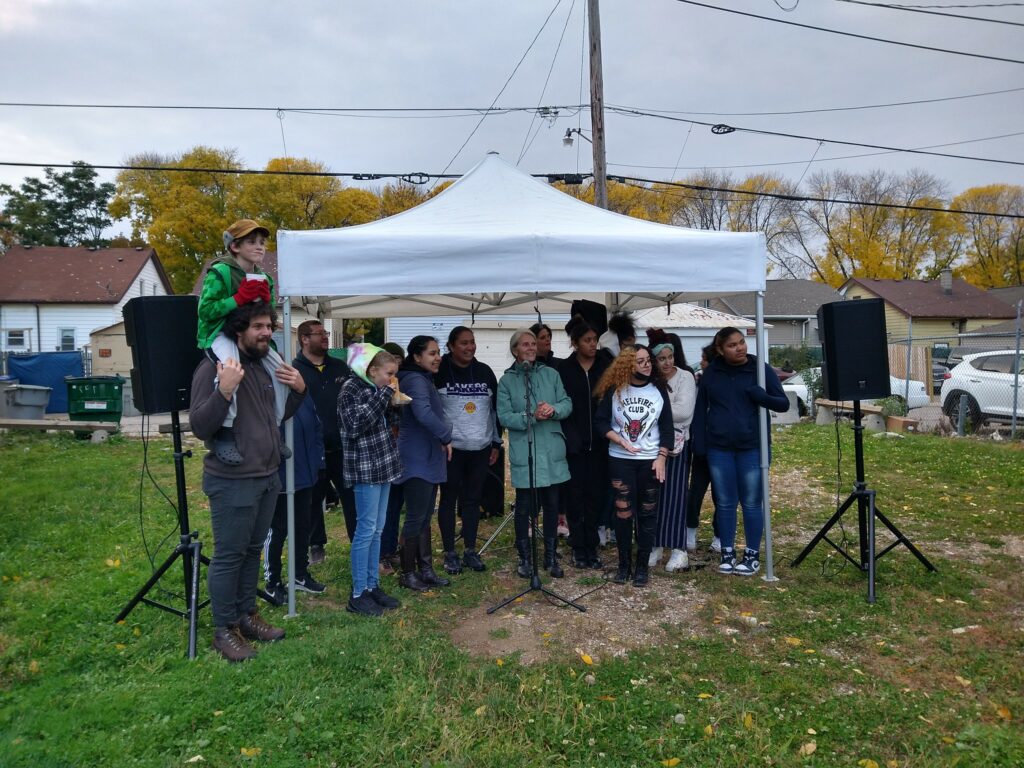La Familia de Arte Makes Art By The People
Southside residents help make 16 new bollards on Cesar Chavez Drive.

Residents gather to celebrate the installation of new bollards on Cesar Chavez Drive. The bollards memorialize lessons learned during the pandemic and the First Nations and immigrant groups that moved to Milwaukee before 1920. (Photo by Sam Woods)
La Familia de Arte recently celebrated the installation of public art memorializing lessons learned from the COVID-19 pandemic as well as memorials to First Nations and immigrant groups who have made Milwaukee home.
The Oct. 13 installations are part of an effort to create public art in the community and to make public artists out of residents who might not think they are.
The bollards, which are sturdy cement cubes with ceramic designs glued on all sides, were made by residents of the near South Side. They were designed and created by local artists and self-described non-artists alike who range in age from grade-schoolers to retirees.
The eight bollards installed on the west side of the street make up a cohesive project called “2022 Pandemic Reflections.” These bollards are based on what community members said they learned during the pandemic. The answers they provided include savoring virtual visits with friends, taking more time to read, spending more time with pets and rediscovering their artistic side.
It is a continuation of last year’s installation that honored those lost to COVID-19 in 2020 and 2021 and recognized everyday neighborhood heroes.
Jean Behrens, a retired art teacher and nurse who serves on La Familia de Arte’s board of directors, was one of those interviewed for “2022 Pandemic Reflections.” She said she learned skills during the pandemic such as baking bread and cooking more meals as restaurants closed. But she also took away more contemplative lessons.
“I really learned how to take better care of myself and appreciate things I used to take for granted,” Behrens said. “Just looking at the world with a broader perspective.”
These include three bollards dedicated to the 12 First Nations of Wisconsin (inscribed on the bollards as Potawatomi, Oneida, Menominee, Ho-Chunk, St. Croix Chippewa, Lac du Flambeau, Bad River, Red Cliff, Brothertown, Mole Lake, La Courte Oreilles and Stockbridge Munsee) and one each for African Americans, Germans and Polish, Irish and Italians.
AnnMarie Ruiz-Carlos, a middle school student who teaches other young artists for La Familia de Arte, said that the organizations consulted members of each community about how to respectfully depict their culture. She remembered learning from a member of the Oneida Nation in particular.
“I think it’s a good thing that we were able to learn from them, because they need more appreciation. They were here before us and they discovered this land,” Ruiz-Carlos said.
From a group of neighbors to an employer
La Familia de Arte did not begin as a 501(c)3 nonprofit but as a group of neighbors dedicated to using art to help their community thrive.
Lori Gramling, who now is the organization’s executive director, said it was around 2005 that the group began meeting as volunteers and soon after were organized under the name “26th Street Project.”
The group continued for about 12 years on small grants and donations that covered the costs of their supplies, but it got a big monetary boost in 2017 from neighbors and eventually local philanthropic institutions and began hiring art teachers from the community to teach.
Gramling said a majority of the funding now goes to salaries and stipends. She said this is important because it allows local people to give their time to the organization without taking second jobs and makes it clear that the work they do at La Familia de Arte is valuable.
“Sometimes people from affluent areas have come and asked the question: ‘Why do you pay people? Shouldn’t they want to do it themselves?’ That (question) only comes from affluent people.” Gramling said. “But there’s a real dignity to it. It makes them feel valued that someone would actually pay them to do this work.”
‘I’ve learned to believe in myself’’
Four years ago, around when the group began to start hiring teachers, Gramling approached Amalia Carlos about a job with the organization. Carlos had volunteered with her two granddaughters before, was apprehensive at first but eventually accepted.
“At first my answer was no,” Carlos said through an interpreter. “I told her I didn’t know how I would be able to help. I am not an artist.”
At last month’s commemoration of the 16 new bollards, Carlos served as La Familia de Arte’s event manager, running around coordinating the distribution of tamales, organizing live music and making small talk with neighbors and leaders who came out to see what she and others had created.
“I’ve learned to draw and paint, but most importantly I’ve learned to believe in myself,” Carlos said.
NNS Spotlight: La Familia de Arte makes artists out of everyday South Siders was originally published by Milwaukee Neighborhood News Service

















